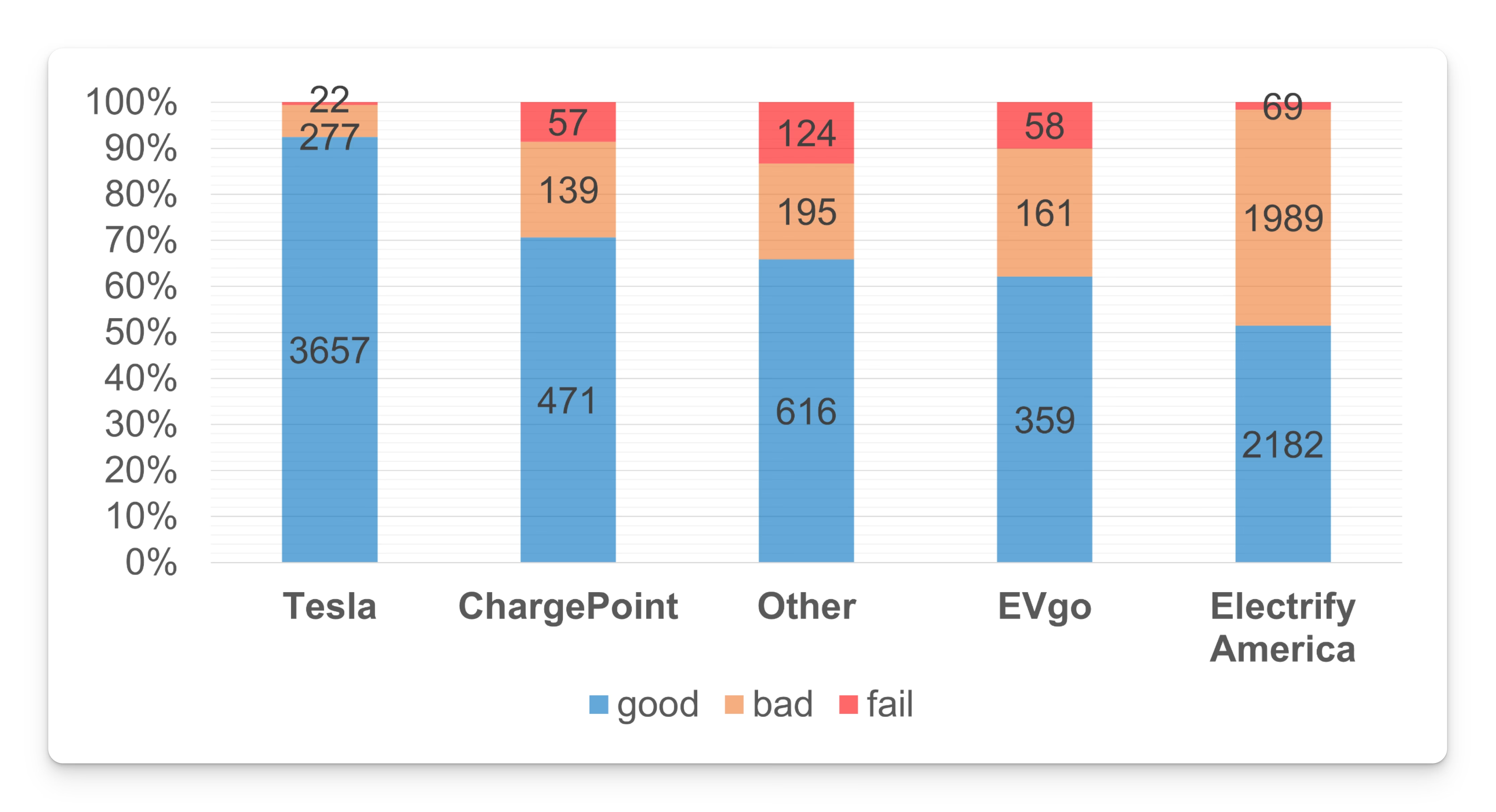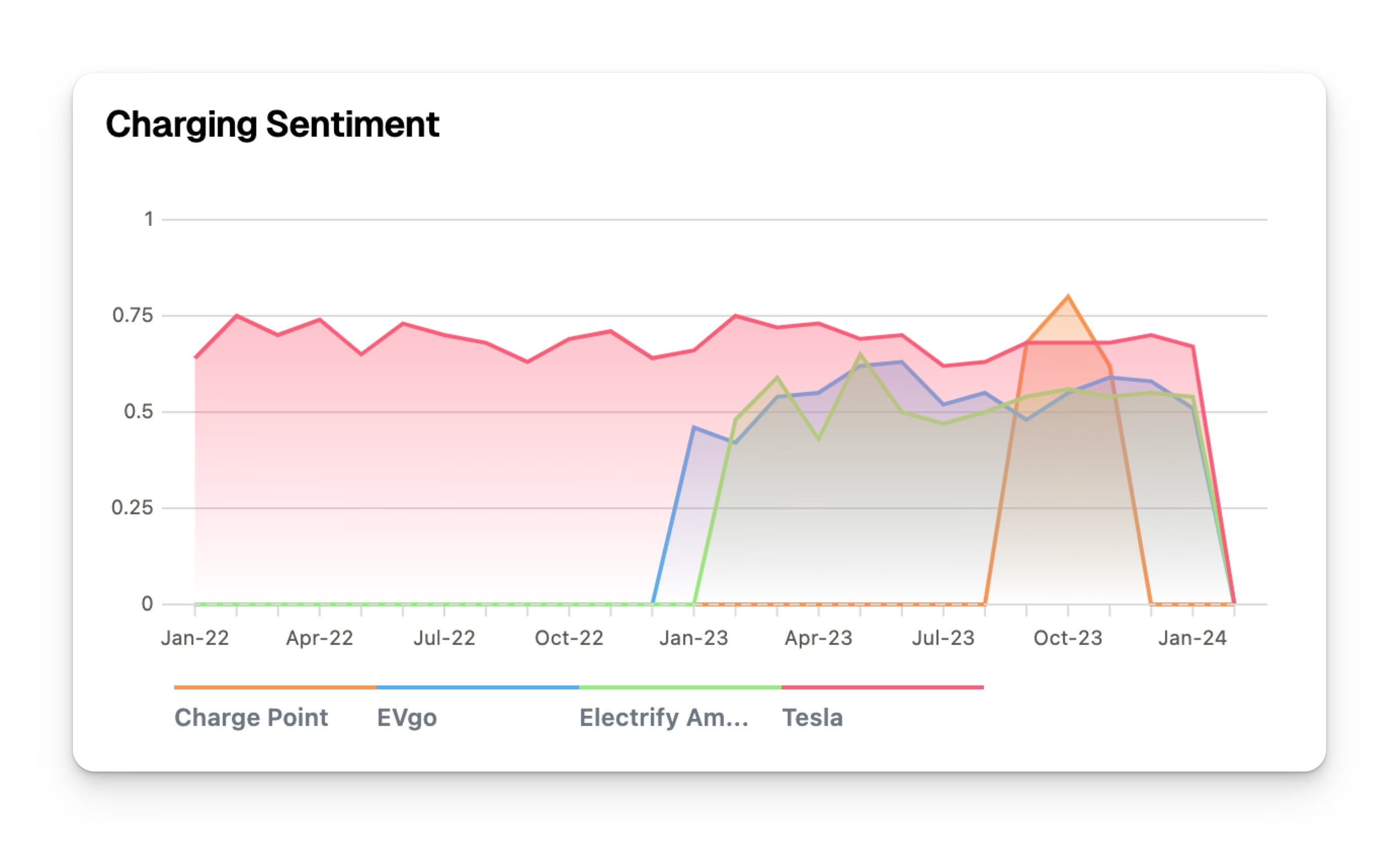The State of EV Charging
Published: 2024-02-04
Lately electric vehicle (EVs) pessimism has seen a noticeable uptick, especially regarding EV charging. This is nothing new for anyone who has been following the evolution of EVs over the last decade. Perhaps this is born in part from the negativity surrounding Elon Musk or because EVs and chargers can have lower performance in cold weather and we are at the tail end of winter at time of writing. Despite these concerns, the convenience and cost benefits of EV charging, especially for those with home charging setups, often surpasses the expierence of internal combustion engine vehicles (ICE). However I did want to cover the current state and shortcomings of charging for EVs and what I believe is needed to enable the full transition to EVs. This post is in part motivated by the excellent work done by the Out of Spec team, and the analysis done through their Rate Your Charge Twitter. But more on that later.
Background
To begin with, let’s provide some background into EV charging for those new to the concept. You’ll mainly encounter two charging speeds: Level 2 (L2) and DC Fast Charging. L2 can be likened to charging your smartphone: you plug it in overnight, and by morning, your vehicle is fully charged and ready to go. Most homeowners can install an L2 charger, which simply uses a 240v outlet similar to a dryer’s. Charging should occur using this method most of the time as it is often the cheapest and most convient method.
On the other hand DC Fast Charging is when you need to charge your vehicle as quickly as possible, like on a road trip. These chargers are more similar to gas stations, with more advanced hardware owned and operated by companies. While L2 chargers typically charge at ~6-20kW a DC Fast Charger can exceed 250 kW depending on both the charger and vehicle hardware.
Although the infrastructure for both charging methods has seen significant advancements, making hardware more accessible and enabling long-distance EV travel across much of the country, there are still challenges. These challenges need to be overcome to pave the way for widespread adoption of EVs by consumers.
Fast Charging
Let’s first start with the state of fast charging. This is where Tesla has led the industry since they launched their first supercharger in 2012. Initially, v1 superchargers could only deliver charging speeds of about 100 kW but today v3 chargers can achieve 250 kW. Tesla has also begun to roll out their v4 chargers with initial speeds of 250kW but with a theoretical capability of 600 kW in the future.
Third-party networks such as Electrify America and EVgo have chargers capable of 350kW today. However, these networks have encountered challenges regarding reliability and user experience, especially regarding software integration and hardware reliability. The experience has been so bad for non-Tesla networks that it led to the Rate Your Charge analysis done on Twitter which collected user feedback to highlight the discrepancies. Their last report highlighted the significant difference between Tesla and third-party networks. Even so Tesla still also has some room for improvement.

And while Rate Your Charge has since stopped these reports I believe they still provided an effective comparison between the networks. In response to the need to compare performance across networks, I built the following dashboard. It performs analysis on Plugshare check-in comments and attempts to categorize experiences on a scale from 0 (Inoperative) to 1 (Flawless). Though not flawless, this approach provides insights into the current state of charging in an automated way. And hopefully, as fast charging improves over time that will be evident on the dashboard. Check out the repo for more details.

Tesla continues to excel in their charging experience with best-in-class software and reliability, not to mention 3x more chargers per location. When there are only 4 chargers and reliability is a concern, 1-2 plugs being inactive can have large consequences, which other networks have struggled with. Andecdotally the only other network outside of Tesla where I have generally always had a good experience is Rivian’s. Rivian’s Adventure Network chargers are currently limited to Rivian owners but they will likely be opening up to all soon similar to Tesla. They have followed Tesla’s playbook, with higher chargers per location, high reliability, and a seamless user experience.
A noteworthy development is the industry’s gradual shift towards the North American Charging Standard (NACS), akin to the transition from Lightning to USB-C in mobile devices. This move, led by Tesla’s decision to open its previously proprietary NACS, promises to streamline the charging experience across various EV models, reducing the complexity associated with competing standards. It is virtually better in every dimension, having smaller, lighter, and less moving parts when compared to the CCS port.
But this may have larger ramifications than many realize. With Tesla opening up their network, and all charging moving to NACS, this means everyone now has to compete on level ground. Charging companies that have historically struggled (Electrify America) may have a tough time competing. Where customers before may have had limited options they will soon have significantly more. Consumers will necessarily gravitate towards a better and cheaper experience. I wouldn’t be surprised if some of these third-party providers struggle to compete, while other providers with seamless experiences like Rivian rise to the top with Tesla.
L2 Charging
The landscape of Level 2 (L2) charging, essential for daily EV use, is more straightforward. If you own a home you can install one of the many L2 chargers sold by automakers or 3rd-party providers. Just get an electrician to wire up a 240v plug, install the L2 charger, and you’re done.
However, the narrative shifts for the approximate one-third of Americans residing in apartments, where L2 chargers are far less common. Some EV owners may be able to utilize charging at work but the convenience is lessened. The only main alternative is fast charging periodically. This is more similar to how ICE vehicles are periodically filled up with gas. Not the end of the world but it is less convenient and for EVs 2-4x more expensive than charging at home (still generally cheaper than gas).
In fact, the frequent use of EV owners using fast chargers has led to some criticism of drivers taking up fast chargers when they shouldn’t. I believe this is unreasonable though as fast chargers are for anyone to use as they please, and because not everyone has full control over their availablity of L2 chargers. And when one considers the incentives there is virtually no reason an EV owner would prefer fast charging over L2 except when speed is needed. The only exception is fueled by automakers who give free fast charging credits with the purchase of the vehicle. This provides an incentive to utilize fast chargers when unnecessary and thus creates artificial demand.
The main challenge with apartments is that charger installation lags behind demand. For a property owner to install the chargers there needs to be demand and a return on investment. If one person owns an EV in an entire complex it may be harder to convince the owner that it is worth the investment. Additionally, if no EVs are present at the apartment it is probably out of mind for the owner until there is a higher prevalence in the US. Because of that L2 installation will likely lag EV adoption, until EVs make up a larger share of the market. The good thing is that this problem can be easily solved through education as L2s are fairly easy to install and relatively cheap, and likely will be over the coming years.
The Future
So that is the current state of charging, but where are we going? As EV adoption grows I think there are two main pain points left for consumers before we see full adoption, L2 availability, and fast charging speeds. I consider L2 availability already on the path to being solved without much more work needed. The market will do its job here and over time L2s will be more common. That leaves fast chargers.
The NACS transition will enable better market dynamics and as charging infrastructure matures, the hardware and software challenges should also disappear. Plug-and-charge is becoming more common, more fast chargers are constantly being deployed, software will show out-of-service plugs with higher accuracy, etc. So what is left to get to mass adoption? I think the last hurdle left is throughput/charging speed.
I believe the sweet spot of charging for most people is 3-4 hours of highway driving in 10 minutes. This is more of an opinion but one that is based on experience. Plugging in, going to the restroom and/or grabbing a snack to eat takes about 10 minutes. Beyond ~10 minutes the time starts to become noticeable. For long road trips where say 3-4 stops are needed 10 minutes keeps it under 1 extra hour, 20-30 minutes per charge can add 1-2 hours which starts to be significant. Ten minutes is also the point where I feel impatient people (those I know) could handle waiting on roadtrips. That is not to say most people can’t handle 15-30 minute charges, but rather the point where I think the vast majority of the country would be fine with it.
Based on testing by Out of Spec it looks like even most top-end cars now get about 120-130 highway miles in 10 minutes, with right around 100 being fairly common. Now that is for cars that they have added to that report, but some missing ones such as the new Porche Taycan and Lucid Air can likely hit 150-180 miles in 10 minutes. But that is still a ways off from what I think is optimal which would require 210-280 miles in 10 minutes. In the last 10 years, a Tesla Model S went from roughly 40 miles added in 10 min to over 120 today, a 3x increase. Now we only need a ~2x improvement to get to a point where range and charging anxiety disappear. With some promising charging advancements and additional efficiency gains, perhaps we will see charging speeds this fast and becoming more common by 2030. Tesla’s v4 chargers have a theoretical peak speed of 600 kW and to hit my target only about 350-500 kW is needed for most vehicles so while v4 may not be the last iteration, it will be the last one needed for a full transition to EVs.
The future is bright for EVs, the issues regarding charging are growing smaller with each passing year. At this point, the transition feels inevitable, especially as solar drives the price of electricity to zero.
I'm on Twitter if you want to follow for more updates. Cheers!